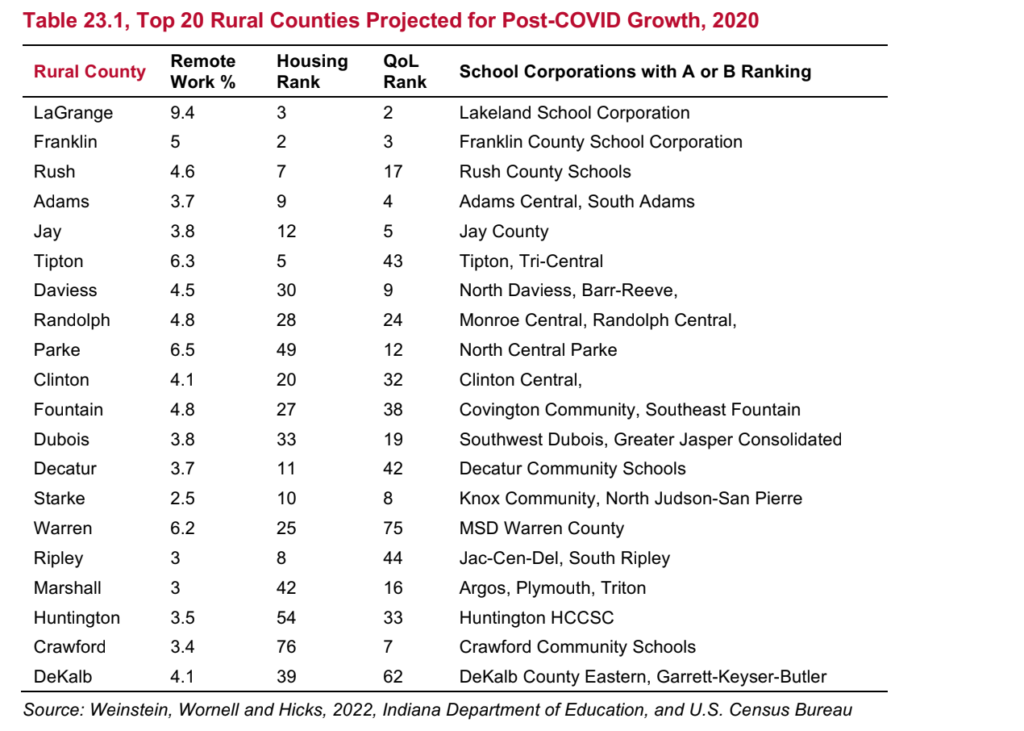By: Carol Johnson, Southern Indiana Business Report
Before the pandemic, three-quarters of American workers had never worked from home.
By May 2020, one third of employed Americans left their offices en masse to work from home because of the pandemic.
Every day was casual Friday as workers attended Zoom meetings in sweats and T-shirts.
Even as COVID guidelines have eased, the workplace for many did not return to pre-COVID days.
The workplace has evolved with workers seeking and employers offering flexible remote work schedules.
A study by Ball State University, the State of the Rural Economy in Indiana, found that rural counties are uniquely positioned to capitalize on workers who are no longer geographically tied to their jobs.

In an environment where workers can do their job from anywhere, some are relocating, whether it’s a return to their hometowns or seeking solace from large urban cities.
Three southwest Indiana counties are ranked in the top 20 of rural counties that could benefit from workers relocating.
Daviess, Dubois and Crawford counties scored high on four criteria: housing, quality of life, schools with an A or B ranking and percentage of remote workers.
Bryant Niehoff, executive director of Daviess County Economic Development Corporation, said the study confirms the work Daviess County has done to expand opportunities.
“It validates our work to improve quality of place, quality of life and invest in housing,” he said. “And we have some vital broadband projects that are happening.”
Because remote workers already have jobs, when considering a relocation, they seek communities that offer amenities such as recreation and quality schools.
Niehoff pointed to Glendale Fish & Wildlife Area near Montgomery and West Boggs Park as big draws.
The study notes that with 1 in 5 Hoosiers living in a rural county, retaining talent is key. To that end, Daviess County joined Radius Indiana’s Choose Southern Indiana program, which provides incentives to individuals who re-locate to a participating county.
Choose Southern Indiana offers a $5,000 relocation incentive to qualified out-of-state individuals or families who relocate to the region. Those who relocate to southern Indiana must maintain residency for a minimum of two years. Such incentive programs are being increasingly used by states and communities throughout the country to attract talent
“When we started it, it was very much a pilot program,” Niehoff said. “So far, Daviess has attracted eight individuals plus their families. Our goal is to retain talent.”
Some of those who have relocated work remotely and some have taken jobs in the Daviess County area.
Not a true forecast
COVID’s affect on the workplace happened suddenly, and the study’s authors note that the rankings aren’t a formal forecast but rather highlight the counties that “already display the characteristics we believe will be connected to the post-COVID changes to residency.”
Also mentioned is a McKinsey study that reports between 20-25% of jobs could be performed remotely for three to five days a week. Another study reports that as much as 56% of American workers can work at least part-time from home.
The data on remote work Ball State used is from 2020 when 4.5% of Daviess County residents worked remotely.
Niehoff said while the county hasn’t intentionally tried to attract remote workers, but by investing in broadband and quality of place, the county has created an environment where the remote worker can thrive.
“High speed broadband is a must for remote workers. Our schools, recreation and housing all together creates an environment to be competitive on attracting remote workers,” Niehoff said.
Proximity to Interstate 69 is another advantage.
“If your office is in Indianapolis, Bloomington or Evansville and maybe you have family ties in Daviess County, or you want space to breathe in a hometown environment, then Daviess County is a good choice for you and you can hop on 69 and be in those large cities easily.”
Key takeaways from the Ball State study:
- In today’s economy, most occupations can be performed anywhere, so household location decisions are motivated by quality of life.
- Businesses increasingly rely upon labor quality for profitability, and they increasingly move to communities with a growing population of educated workers.
- Educational attainment levels in rural counties are below the Indiana and national averages and are growing more slowly. Thus, educational attainment in rural Indiana is in relative decline.
- Places with a higher quality of life attract people and jobs more quickly than places with a lower quality of life.
- Higher quality of life is strongly correlated with more school spending, the absence of crime and a few private sector amenities, such as recreational activities.



